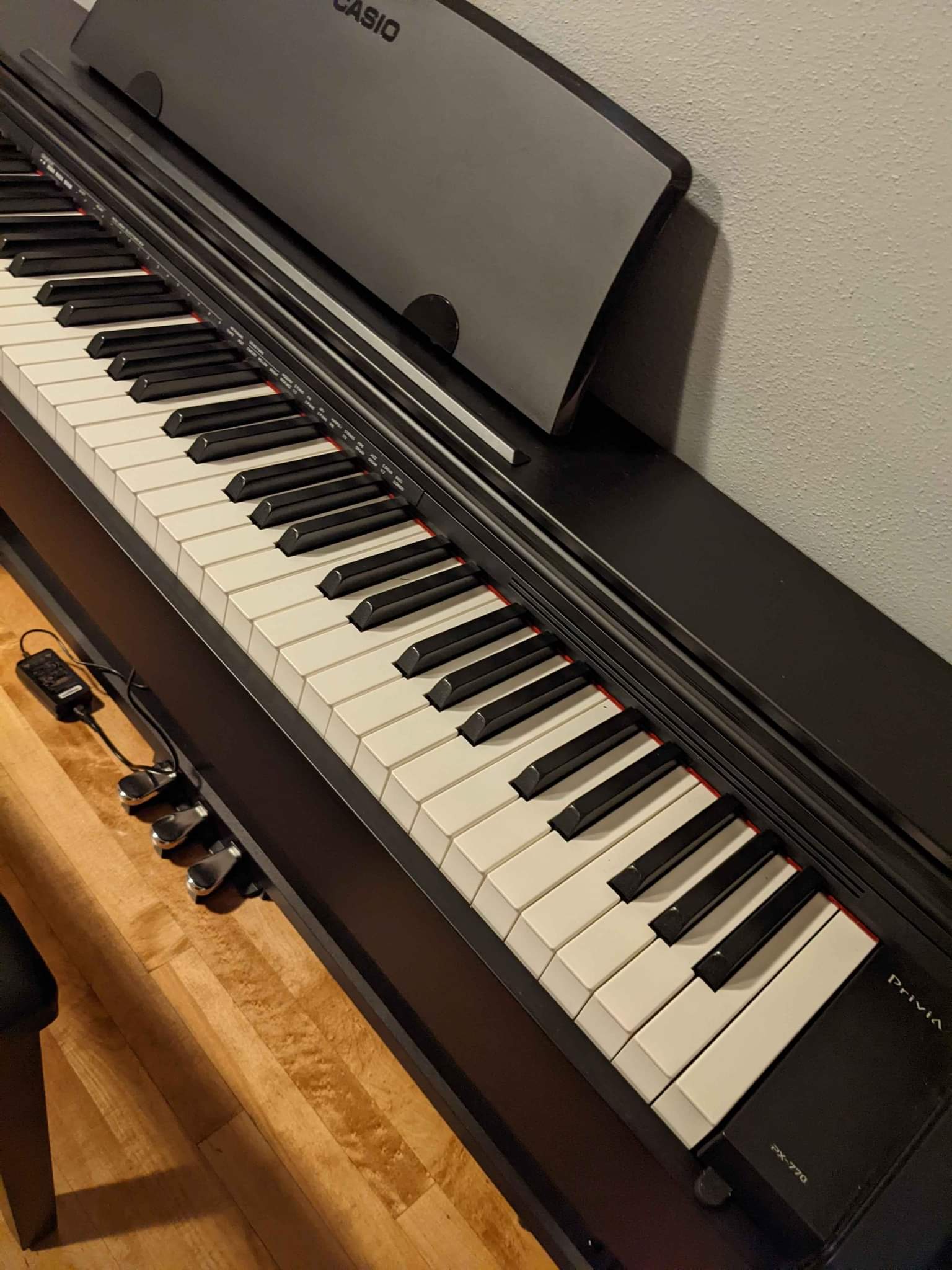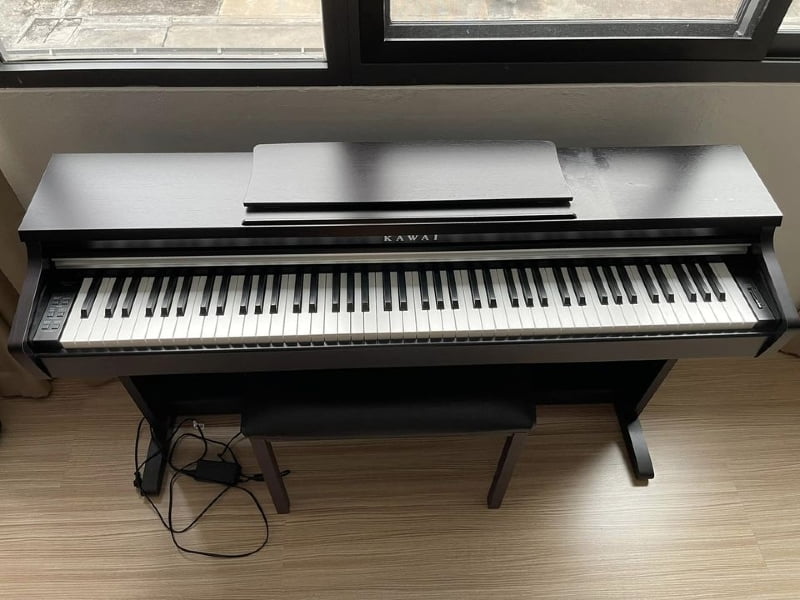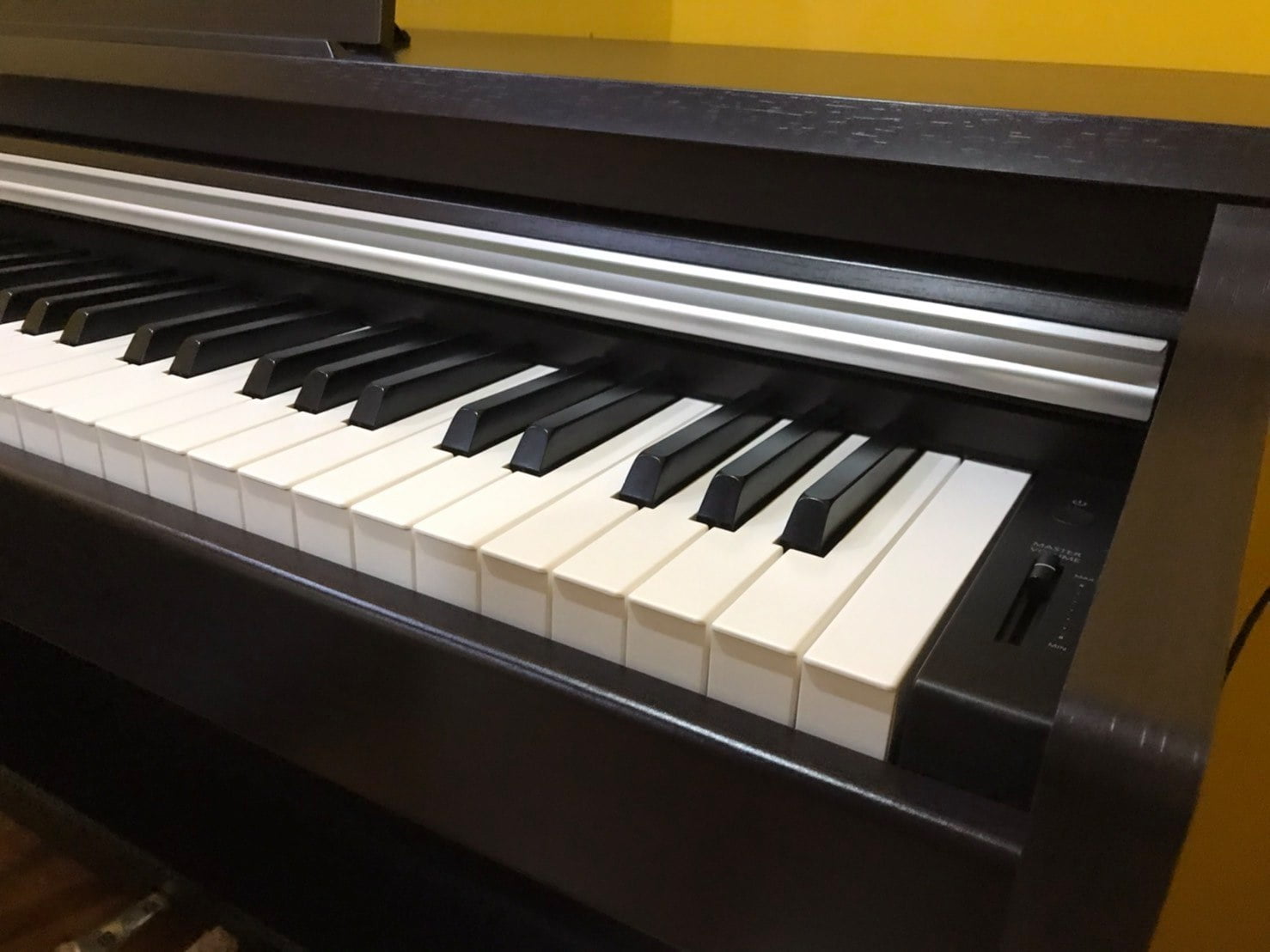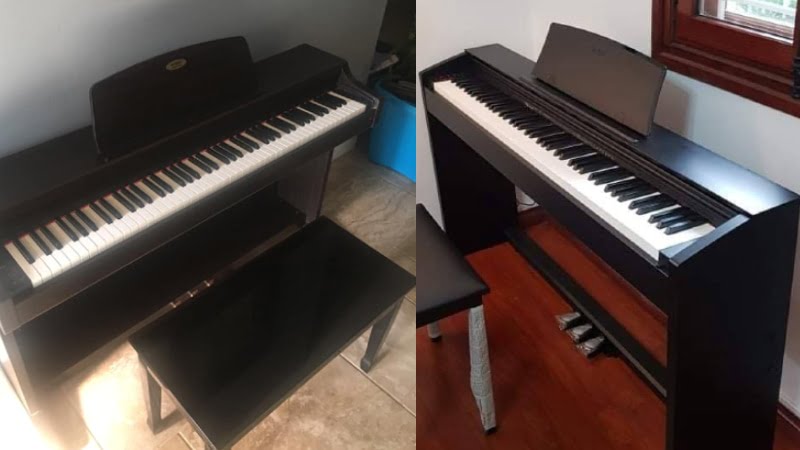Learn the differences and features of both of these pianos in this Casio PX-770 vs Kawai KDP-110 review.
Console digital pianos are a great investment. Not only do they sound great and come with various voices, but they can also replicate the look and feel of an acoustic piano. So, if you want to place an acoustic piano in your home but don’t want to spend that much on one, a console digital piano is a great alternative.
And in this Casio PX-770 vs Kawai KDP-110 comparison, we’re looking at two very popular console digital pianos available today.
Not only do these pianos sound great and feel realistic, but they’re also some of the most affordable options on the market. And while the comparison was very close, I chose the Kawai KDP-110 as the winner.
It had a more realistic feel and more piano features, so it was the clear choice, even if the Casio PX-770 had a slightly more realistic tone. I’ll get into more detail about this comparison below, so keep reading to learn more.
Casio PX-770 vs Kawai KDP-110: Comparison Chart




Last update on 2024-07-25 / Affiliate links / Images from Amazon Product Advertising API
Casio PX-770 vs Kawai KDP-110: A Head-to-Head Comparison
After comparing the tones, feel, and piano features of both instruments, the Kawai KDP-110 was the definite winner. The score at the end of it all was 2-1 in favor of the Kawai, which shows how close of a fight this comparison was.
Both of these pianos are great options, especially when shopping in the sub-$1,000 range. However, while the Casio PX-770’s tone was more realistic and it had a wider sound library, I found the feel and piano features sub-par compared to the KDP-110, which is why it couldn’t win the entire comparison.
Tone
The winner: Casio PX-770
I always check out the tone when I first get my hands on a digital piano. And as expected, both the Casio PX-770 and Kawai KDP-110 offer a premium sound that’s very close to an acoustic piano. However, when compared side by side, I found the Casio’s voices to be much clearer, and since it also has a larger sound library, it beat out the Kawai in this category.

+Tone Generator
The Kawai KDP-110 uses Harmonic Imaging. This is an advanced technology that uses the highest-quality recordings of different instruments to produce a sound. The Casio PX-770, on the other hand, uses a similar technology known as the Acoustic and Intelligent Resonator (AiR).
I had no problems with either tone generator. In fact, these tone generators can easily compete with many of the options that are in higher price ranges. However, when comparing them side by side, I noticed more clarity and detail in the Casio’s voices, especially in the grand piano sounds.
The difference is very small, but it’s still noticeable. So, if you’re very particular about a piano’s tone, you might be better off with the Casio PX-770.
+Sound Library
On top of having clearer and crisper tones, the Casio PX-770 also features a wider sound library. The Kawai KDP-110 only has 15 tones, which include all the basics, but it’s still limited. On the flip side, the Casio PX-770 has over 19 voices, each of which are high-quality and useful.
The Casio doesn’t have that much more voices as the KDP-110, but as a pianist, it’s always important to have variety. With the Casio, you get more choices when playing the instrument, allowing you to tweak the tone to fit into various musical styles.
While console digital pianos aren’t the most flexible instruments since they aren’t portable, it’s nice that the Casio model has a wide sound library that gives you more flexibility than usual.
That said, remember that tone is a very subjective topic. Every pianist has their own preferences and tastes when it comes to piano tones. This is why it’s always best to find ways to test the instrument and listen to the tone first-hand whenever you buy a digital piano.

Feel
The winner: Kawai KDP-110
The next comparison point was the feel. Most pianists will say that they can instantly tell when they’re playing a digital piano without even looking at it. This is because it’s very hard for a digital piano to capture the exact feel of an acoustic piano.
However, both the Kawai KDP-110 and Casio PX-770 do their best to emulate the feeling of playing a real acoustic piano. Between the two, I found that the Kawai KDP-110 felt a bit more realistic, and below, I’ll explain why.
+Hammer Action
The Casio PX-770 uses the Scaled Hammer Action system. I really enjoyed this as this hammer action feels very close to the weight of an acoustic piano. When you press on the keys, you’ll notice that the bass notes are slightly heavier than the higher notes, which is how most acoustic pianos are set up.
This gives you an additional layer of realism that beats out other models that only have fully-weighted keys. And to my surprise, the Kawai KDP-110’s, Responsive Hammer Action II system was able to do the same thing but even better than the Casio.
This is because, aside from having a slight weight difference on the keys, the piano also has a spring-back system. When you play a premium piano, there is a distinct rebound whenever you press a key which the Casio doesn’t have. The Kawai does have this feature, which is why it easily won the point when I compared the feel and hammer action of both pianos.
Piano Features
The winner: Kawai KDP-110
Lastly, I compared the piano features of the two pianos. And again, the Kawai KDP-110 won the comparison. It had much better polyphony, which is one of the most important extra features to consider with modern digital pianos. So, the Kawai KDP-110 won the tie-breaking point, which is how it ended up winning the entire comparison.
+Polyphony
Polyphony is very important when you want to experiment with different playing modes or if you want to add expression to your playing with the sustain pedal. Ideally, you want to have more than 96-note polyphony with a digital piano. This is why I was very happy to see that the Casio PX-770 came with 128-note maximum polyphony.
While this was already impressive, the Kawai KDP-110 came with 196-note polyphony. This makes a major difference as you can experiment more with different playing modes, combine various tones, and of course, keep the sustain pedal on and expect the notes to ring out for a long time.

Casio PX-770 vs Kawai KDP-110: The Similarities
The most significant similarity between these two pianos is the fact that they are console pianos. A console piano is meant to stay in one place and replicate the look and sound of a fully acoustic piano. While you lack some of the flexibility you get when you buy a portable digital piano, you make up for it with a better sound and feel, which is why console digital pianos are great investments.
On top of that, both of these pianos fall comfortably in the sub-$1000 price range. This is quite a surprise as most console digital pianos that sound great and last a long time require you to spend a fair amount of money. And in my opinion, these are arguably some of the best console digital pianos available for those that don’t want to bust the bank.
Another similarity is that both of these pianos come with a set of playing modes. Most of the time, budget-friendly digital pianos don’t have different playing modes, and if they do, they are low-quality and aren’t worth using. However, when testing out both of these models, I found the playing modes to be very practical and sound great, which is another bonus of getting these pianos.
Quick Rundown of the Casio PX-770
- 88 scaled, weighted hammer-action keys with simulated ebony and ivory textures
- Stunning new piano sound with detailed resonance, plus 18 other Tones
- Stereo speaker system built into stylish, modern wooden cabinet
- Versatile practice, performance, and MIDI recording tools
- 3 year manufacturer extended warranty
Last update on 2024-07-25 / Affiliate links / Images from Amazon Product Advertising API
Quick Rundown of the Kawai KDP-110
Last update on 2024-07-25 / Affiliate links / Images from Amazon Product Advertising API
Product Video
Related Articles to Casio Px 770
- Casio PX-770 vs Korg B2SP: A Battle of Budget Console Digital Pianos?
- Casio PX-770 vs Kawai ES-110: Should You Get A Portable or Console Digital Piano?
- Casio PX-770 vs PX-160: Should You Get A Portable or Console Digital Piano?
- Casio PX-770 vs S1000: Should You Get A Portable or Console Digital Piano?
- Casio PX-770 vs 750: Finding the Best Budget Digital Piano
- Casio PX-770 vs PX-860: Should You Get A Portable or Console Digital Piano?
- Casio PX-770 Vs AP-270: Which Casio Model Wins Out?
- Casio PX-770 Vs 760: Which Is The Better Casio Privia Model?
- Casio PX-770 Vs Yamaha DGX-660: Should You Get A Portable Or Console Digital Piano?
- Casio PX-770 Vs Yamaha YDP-143: Which Is The Better Piano For The Money?
- Casio PX-770 Vs Roland FP-30: Should You Get A Portable or Console Digital Piano?
- Casio PX-770 vs Yamaha YDP-144: Which Is The Better Digital Piano?
- Casio PX-770 Vs 780: What’s The Difference Between These Two Digital Pianos?
- Casio PX-770 Vs 870: Which Casio Console Digital Piano Is Better?
- Yamaha P45 vs Casio PX 770: Should You Get the Portable or Console Digital Piano?
- Yamaha P125 vs Casio PX-770 Review: Why the Yamaha P125 Beats Out the Casio Console Digital Piano
Related Articles to Kawai Kdp 110
- Yamaha YDP-144 vs Kawai KDP-110: Why the YDP-144 Is the Better Piano
- Casio PX-870 Vs Kawai KDP-110: The Best Digital Pianos In The Price Range?
References:
- Casio PX-770: https://www.sweetwater.com/store/detail/PX770BK–casio-privia-px-770-black-finish
- Kawai KDP-110: https://www.kawai-global.com/product/kdp110/
Lulacruza is an electronic folk duo operating at the junction of the hypermodern and the ancient. Our music weaves together hypnotic female singing, South American folk instruments and electronic processing, while channeling pulsating waves from the source of creation.
Lalucruza is also a community where you can connect with other music lovers to collaborate, exchange ideas and share knowledge. A platform for who wants to learns the basics of playing piano, guitar, drum masters’ technique, etc.. is the premise of our website.
